The Development of Robust Antibodies to Sarcospan, a Dystrophin- and Integrin-Associated Protein, for Basic and Translational Research
Abstract
1. Introduction
2. Results
2.1. Development of Rabbit Polyclonal Antibody to N-Terminus of Mouse SSPN
2.2. Development of Rabbit Monoclonal Antibody to N-Terminus of Mouse SSPN
2.3. Development of Mouse Monoclonal Antibodies to the LEL Fragment and C-Terminus of Human SSPN
3. Discussion
4. Materials and Methods
4.1. SSPN B-Cell Linear Epitope Prediction
4.2. Rabbit Antibody Development to N-Terminus of Mouse SSPN
4.2.1. Recombinant SSPN Protein Production
4.2.2. Rabbit Immunization
4.2.3. Indirect Enzyme-Linked Immunosorbent Assay (ELISA) for Detection of Recombinant SSPN
4.2.4. Immunoblotting for Detection of SSPN in Skeletal Muscle Protein Lysates
4.2.5. Indirect Immunofluorescent Analysis (IFA) for Detection of SSPN in Transverse Cryosections of Human and Mouse Skeletal Muscle
4.2.6. Isolation and Sorting of Rabbit B-Cells
4.2.7. Generation of the Linear Expression Modules (LEMs)
4.3. Development of Mouse Antibodies to the Large Extracellular Loop and C-Terminus of Human SSPN
4.3.1. Generation of Synthetic SSPN Polypeptides
4.3.2. Immunizations and Evaluation of Mouse Immune Response to hSSPN
4.3.3. Mouse Monoclonal Antibody Generation
4.4. Determining the Efficiency of Immunoprecipitation for Affinity Purification of SSPN
5. Conclusions
Supplementary Materials
Author Contributions
Funding
Institutional Review Board Statement
Informed Consent Statement
Data Availability Statement
Acknowledgments
Conflicts of Interest
Abbreviations
References
- Marshall, J.L.; Crosbie-Watson, R.H. Sarcospan: A small protein with large potential for Duchenne muscular dystrophy. Skelet. Muscle 2013, 3, 1. [Google Scholar] [CrossRef]
- McCourt, J.L.; Stearns-Reider, K.M.; Mamsa, H.; Kannan, P.; Afsharinia, M.H.; Shu, C.; Gibbs, E.M.; Shin, K.M.; Kurmangaliyev, Y.Z.; Schmitt, L.R.; et al. Multi-omics analysis of sarcospan overexpression in mdx skeletal muscle reveals compensatory remodeling of cytoskeleton-matrix interactions that promote mechanotransduction pathways. Skelet. Muscle 2023, 13, 1. [Google Scholar] [CrossRef] [PubMed]
- Crosbie, R.H.; Heighway, J.; Venzke, D.P.; Lee, J.C.; Campbell, K.P. Sarcospan, the 25-kDa transmembrane component of the dystrophin-glycoprotein complex. J. Biol. Chem. 1997, 272, 31221–31224. [Google Scholar] [CrossRef] [PubMed]
- Crosbie, R.H.; Lebakken, C.S.; Holt, K.H.; Venzke, D.P.; Straub, V.; Lee, J.C.; Grady, R.M.; Chamberlain, J.S.; Sanes, J.R.; Campbell, K.P. Membrane targeting and stabilization of sarcospan is mediated by the sarcoglycan subcomplex. J. Cell Biol. 1999, 145, 153–165. [Google Scholar] [CrossRef] [PubMed]
- Parvatiyar, M.S.; Brownstein, A.J.; Kanashiro-Takeuchi, R.M.; Collado, J.R.; Dieseldorff Jones, K.M.; Gopal, J.; Hammond, K.G.; Marshall, J.L.; Ferrel, A.; Beedle, A.M.; et al. Stabilization of the cardiac sarcolemma by sarcospan rescues DMD-associated cardiomyopathy. JCI Insight 2019, 5, 11. [Google Scholar] [CrossRef] [PubMed]
- Miller, G.; Wang, E.L.; Nassar, K.L.; Peter, A.K.; Crosbie, R.H. Structural and functional analysis of the sarcoglycan-sarcospan subcomplex. Exp. Cell Res. 2007, 313, 639–651. [Google Scholar] [CrossRef] [PubMed]
- Durbeej, M.; Campbell, K.P. Muscular dystrophies involving the dystrophin-glycoprotein complex: An overview of current mouse models. Curr. Opin. Genet. Dev. 2002, 12, 349–361. [Google Scholar] [CrossRef] [PubMed]
- Crosbie, R.H.; Lim, L.E.; Moore, S.A.; Hirano, M.; Hays, A.P.; Maybaum, S.W.; Collin, H.; Dovico, S.A.; Stolle, C.A.; Fardeau, M.; et al. Molecular and genetic characterization of sarcospan: Insights into sarcoglycan-sarcospan interactions. Hum. Mol. Genet. 2000, 9, 2019–2027. [Google Scholar] [CrossRef] [PubMed]
- Durbeej, M.; Cohn, R.D.; Hrstka, R.F.; Moore, S.A.; Allamand, V.; Davidson, B.L.; Williamson, R.A.; Campbell, K.P. Disruption of the beta-sarcoglycan gene reveals pathogenetic complexity of limb-girdle muscular dystrophy type 2E. Mol. Cell 2000, 5, 141–151. [Google Scholar] [CrossRef]
- Coral-Vazquez, R.; Cohn, R.D.; Moore, S.A.; Hill, J.A.; Weiss, R.M.; Davisson, R.L.; Straub, V.; Barresi, R.; Bansal, D.; Hrstka, R.F.; et al. Disruption of the sarcoglycan-sarcospan complex in vascular smooth muscle: A novel mechanism for cardiomyopathy and muscular dystrophy. Cell 1999, 98, 465–474. [Google Scholar] [CrossRef]
- Duclos, F.; Straub, V.; Moore, S.A.; Venzke, D.P.; Hrstka, R.F.; Crosbie, R.H.; Durbeej, M.; Lebakken, C.S.; Ettinger, A.J.; van der Meulen, J.; et al. Progressive muscular dystrophy in alpha-sarcoglycan-deficient mice. J. Cell Biol. 1998, 142, 1461–1471. [Google Scholar] [CrossRef]
- Peter, A.K.; Marshall, J.L.; Crosbie, R.H. Sarcospan reduces dystrophic pathology: Stabilization of the utrophin-glycoprotein complex. J. Cell Biol. 2008, 183, 419–427. [Google Scholar] [CrossRef] [PubMed]
- Marshall, J.L.; Holmberg, J.; Chou, E.; Ocampo, A.C.; Oh, J.; Lee, J.; Peter, A.K.; Martin, P.T.; Crosbie-Watson, R.H. Sarcospan-dependent Akt activation is required for utrophin expression and muscle regeneration. J. Cell Biol. 2012, 197, 1009–1027. [Google Scholar] [CrossRef]
- Marshall, J.L.; Oh, J.; Chou, E.; Lee, J.A.; Holmberg, J.; Burkin, D.J.; Crosbie-Watson, R.H. Sarcospan integration into laminin-binding adhesion complexes that ameliorate muscular dystrophy requires utrophin and alpha7 integrin. Hum. Mol. Genet. 2015, 24, 2011–2022. [Google Scholar] [CrossRef] [PubMed]
- Mamsa, H.; Stark, R.L.; Shin, K.M.; Beedle, A.M.; Crosbie, R.H. Sarcospan increases laminin-binding capacity of alpha-dystroglycan to ameliorate DMD independent of Galgt2. Hum. Mol. Genet. 2022, 31, 718–732. [Google Scholar] [CrossRef] [PubMed]
- Marshall, J.L.; Chou, E.; Oh, J.; Kwok, A.; Burkin, D.J.; Crosbie-Watson, R.H. Dystrophin and utrophin expression require sarcospan: Loss of alpha7 integrin exacerbates a newly discovered muscle phenotype in sarcospan-null mice. Hum. Mol. Genet. 2012, 21, 4378–4393. [Google Scholar] [CrossRef]
- Gibbs, E.M.; Marshall, J.L.; Ma, E.; Nguyen, T.M.; Hong, G.; Lam, J.S.; Spencer, M.J.; Crosbie-Watson, R.H. High levels of sarcospan are well tolerated and act as a sarcolemmal stabilizer to address skeletal muscle and pulmonary dysfunction in DMD. Hum. Mol. Genet. 2016, 25, 5395–5406. [Google Scholar] [CrossRef]
- Parvatiyar, M.S.; Marshall, J.L.; Nguyen, R.T.; Jordan, M.C.; Richardson, V.A.; Roos, K.P.; Crosbie-Watson, R.H. Sarcospan Regulates Cardiac Isoproterenol Response and Prevents Duchenne Muscular Dystrophy-Associated Cardiomyopathy. J. Am. Heart Assoc. 2015, 4, e002481. [Google Scholar] [CrossRef]
- Peter, A.K.; Miller, G.; Crosbie, R.H. Disrupted mechanical stability of the dystrophin-glycoprotein complex causes severe muscular dystrophy in sarcospan transgenic mice. J. Cell Sci. 2007, 120, 996–1008. [Google Scholar] [CrossRef]
- Shu, C.; Kaxon-Rupp, A.N.; Collado, J.R.; Damoiseaux, R.; Crosbie, R.H. Development of a high-throughput screen to identify small molecule enhancers of sarcospan for the treatment of Duchenne muscular dystrophy. Skelet. Muscle 2019, 9, 32. [Google Scholar] [CrossRef]
- Shu, C.; Parfenova, L.; Mokhonova, E.; Collado, J.R.; Damoiseaux, R.; Campagna, J.; John, V.; Crosbie, R.H. High-throughput screening identifies modulators of sarcospan that stabilize muscle cells and exhibit activity in the mouse model of Duchenne muscular dystrophy. Skelet. Muscle 2020, 10, 26. [Google Scholar] [CrossRef] [PubMed]
- Shu, C.; Mokhonova, E.; Crosbie, R.H. High-Throughput Screening to Identify Modulators of Sarcospan. Methods Mol. Biol. 2023, 2587, 479–493. [Google Scholar] [CrossRef] [PubMed]
- Lebakken, C.S.; Venzke, D.P.; Hrstka, R.F.; Consolino, C.M.; Faulkner, J.A.; Williamson, R.A.; Campbell, K.P. Sarcospan-deficient mice maintain normal muscle function. Mol. Cell Biol. 2000, 20, 1669–1677. [Google Scholar] [CrossRef] [PubMed]
- Pedrioli, A.; Oxenius, A. Single B cell technologies for monoclonal antibody discovery. Trends Immunol. 2021, 42, 1143–1158. [Google Scholar] [CrossRef] [PubMed]
- Starkie, D.O.; Compson, J.E.; Rapecki, S.; Lightwood, D.J. Generation of Recombinant Monoclonal Antibodies from Immunised Mice and Rabbits via Flow Cytometry and Sorting of Antigen-Specific IgG+ Memory B Cells. PLoS ONE 2016, 11, e0152282. [Google Scholar] [CrossRef] [PubMed]
- Lei, L.; Tran, K.; Wang, Y.; Steinhardt, J.J.; Xiao, Y.; Chiang, C.I.; Wyatt, R.T.; Li, Y. Antigen-Specific Single B Cell Sorting and Monoclonal Antibody Cloning in Guinea Pigs. Front. Microbiol. 2019, 10, 672. [Google Scholar] [CrossRef]
- Garcia-Espana, A.; Chung, P.J.; Sarkar, I.N.; Stiner, E.; Sun, T.T.; Desalle, R. Appearance of new tetraspanin genes during vertebrate evolution. Genomics 2008, 91, 326–334. [Google Scholar] [CrossRef] [PubMed]
- Hemler, M.E. Tetraspanin functions and associated microdomains. Nat. Rev. Mol. Cell Biol. 2005, 6, 801–811. [Google Scholar] [CrossRef]
- Levy, S.; Shoham, T. The tetraspanin web modulates immune-signalling complexes. Nat. Rev. Immunol. 2005, 5, 136–148. [Google Scholar] [CrossRef]
- Yanez-Mo, M.; Barreiro, O.; Gordon-Alonso, M.; Sala-Valdes, M.; Sanchez-Madrid, F. Tetraspanin-enriched microdomains: A functional unit in cell plasma membranes. Trends Cell Biol. 2009, 19, 434–446. [Google Scholar] [CrossRef]
- Stipp, C.S.; Kolesnikova, T.V.; Hemler, M.E. Functional domains in tetraspanin proteins. Trends Biochem. Sci. 2003, 28, 106–112. [Google Scholar] [CrossRef] [PubMed]
- Levy, S.; Shoham, T. Protein-protein interactions in the tetraspanin web. Physiology 2005, 20, 218–224. [Google Scholar] [CrossRef] [PubMed]
- van Deventer, S.J.; Dunlock, V.E.; van Spriel, A.B. Molecular interactions shaping the tetraspanin web. Biochem. Soc. Trans. 2017, 45, 741–750. [Google Scholar] [CrossRef] [PubMed]
- Hemler, M.E. Specific tetraspanin functions. J. Cell Biol. 2001, 155, 1103–1107. [Google Scholar] [CrossRef]
- Kitadokoro, K.; Bordo, D.; Galli, G.; Petracca, R.; Falugi, F.; Abrignani, S.; Grandi, G.; Bolognesi, M. CD81 extracellular domain 3D structure: Insight into the tetraspanin superfamily structural motifs. EMBO J. 2001, 20, 12–18. [Google Scholar] [CrossRef] [PubMed]
- Seigneuret, M.; Delaguillaumie, A.; Lagaudriere-Gesbert, C.; Conjeaud, H. Structure of the tetraspanin main extracellular domain. A partially conserved fold with a structurally variable domain insertion. J. Biol. Chem. 2001, 276, 40055–40064. [Google Scholar] [CrossRef] [PubMed]
- Zhang, X.A.; Bontrager, A.L.; Hemler, M.E. Transmembrane-4 superfamily proteins associate with activated protein kinase C (PKC) and link PKC to specific beta(1) integrins. J. Biol. Chem. 2001, 276, 25005–25013. [Google Scholar] [CrossRef] [PubMed]
- Tejera, E.; Rocha-Perugini, V.; Lopez-Martin, S.; Perez-Hernandez, D.; Bachir, A.I.; Horwitz, A.R.; Vazquez, J.; Sanchez-Madrid, F.; Yanez-Mo, M. CD81 regulates cell migration through its association with Rac GTPase. Mol. Biol. Cell 2013, 24, 261–273. [Google Scholar] [CrossRef] [PubMed]
- Marshall, J.L.; Kwok, Y.; McMorran, B.J.; Baum, L.G.; Crosbie-Watson, R.H. The potential of sarcospan in adhesion complex replacement therapeutics for the treatment of muscular dystrophy. FEBS J. 2013. [Google Scholar] [CrossRef]
- Ayoub, M.A.; Crepieux, P.; Koglin, M.; Parmentier, M.; Pin, J.P.; Poupon, A.; Reiter, E.; Smit, M.; Steyaert, J.; Watier, H.; et al. Antibodies targeting G protein-coupled receptors: Recent advances and therapeutic challenges. MAbs 2017, 9, 735–741. [Google Scholar] [CrossRef]
- Peter, A.K.; Miller, G.; Capote, J.; DiFranco, M.; Solares-Perez, A.; Wang, E.L.; Heighway, J.; Coral-Vazquez, R.M.; Vergara, J.; Crosbie-Watson, R.H. Nanospan, an alternatively spliced isoform of sarcospan, localizes to the sarcoplasmic reticulum in skeletal muscle and is absent in limb girdle muscular dystrophy 2F. Skelet. Muscle 2017, 7, 11. [Google Scholar] [CrossRef] [PubMed]
- Hemler, M.E. Targeting of tetraspanin proteins--potential benefits and strategies. Nat. Rev. Drug Discov. 2008, 7, 747–758. [Google Scholar] [CrossRef] [PubMed]
- Miller, G.; Peter, A.K.; Espinoza, E.; Heighway, J.; Crosbie, R.H. Over-expression of Microspan, a novel component of the sarcoplasmic reticulum, causes severe muscle pathology with triad abnormalities. J. Muscle Res. Cell Motil. 2006, 27, 545–558. [Google Scholar] [CrossRef] [PubMed]
- Von Roemeling, C.A.; Marlow, L.A.; Radisky, D.C.; Rohl, A.; Larsen, H.E.; Wei, J.; Sasinowska, H.; Zhu, H.; Drake, R.; Sasinowski, M.; et al. Functional genomics identifies novel genes essential for clear cell renal cell carcinoma tumor cell proliferation and migration. Oncotarget 2014, 5, 5320–5334. [Google Scholar] [CrossRef] [PubMed]
- Larsen, J.E.; Lund, O.; Nielsen, M. Improved method for predicting linear B-cell epitopes. Immunome Res. 2006, 2, 2. [Google Scholar] [CrossRef] [PubMed][Green Version]
- Jin, A.; Ozawa, T.; Tajiri, K.; Obata, T.; Kondo, S.; Kinoshita, K.; Kadowaki, S.; Takahashi, K.; Sugiyama, T.; Kishi, H.; et al. A rapid and efficient single-cell manipulation method for screening antigen-specific antibody-secreting cells from human peripheral blood. Nat. Med. 2009, 15, 1088–1092. [Google Scholar] [CrossRef] [PubMed]
- Clargo, A.M.; Hudson, A.R.; Ndlovu, W.; Wootton, R.J.; Cremin, L.A.; O’Dowd, V.L.; Nowosad, C.R.; Starkie, D.O.; Shaw, S.P.; Compson, J.E.; et al. The rapid generation of recombinant functional monoclonal antibodies from individual, antigen-specific bone marrow-derived plasma cells isolated using a novel fluorescence-based method. MAbs 2014, 6, 143–159. [Google Scholar] [CrossRef] [PubMed]
- Kohler, G.; Milstein, C. Continuous cultures of fused cells secreting antibody of predefined specificity. Nature 1975, 256, 495–497. [Google Scholar] [CrossRef]
- Phakham, T.; Boonkrai, C.; Wongtangprasert, T.; Audomsun, T.; Attakitbancha, C.; Saelao, P.; Muanwien, P.; Sooksai, S.; Hirankarn, N.; Pisitkun, T. Highly efficient hybridoma generation and screening strategy for anti-PD-1 monoclonal antibody development. Sci. Rep. 2022, 12, 17792. [Google Scholar] [CrossRef]
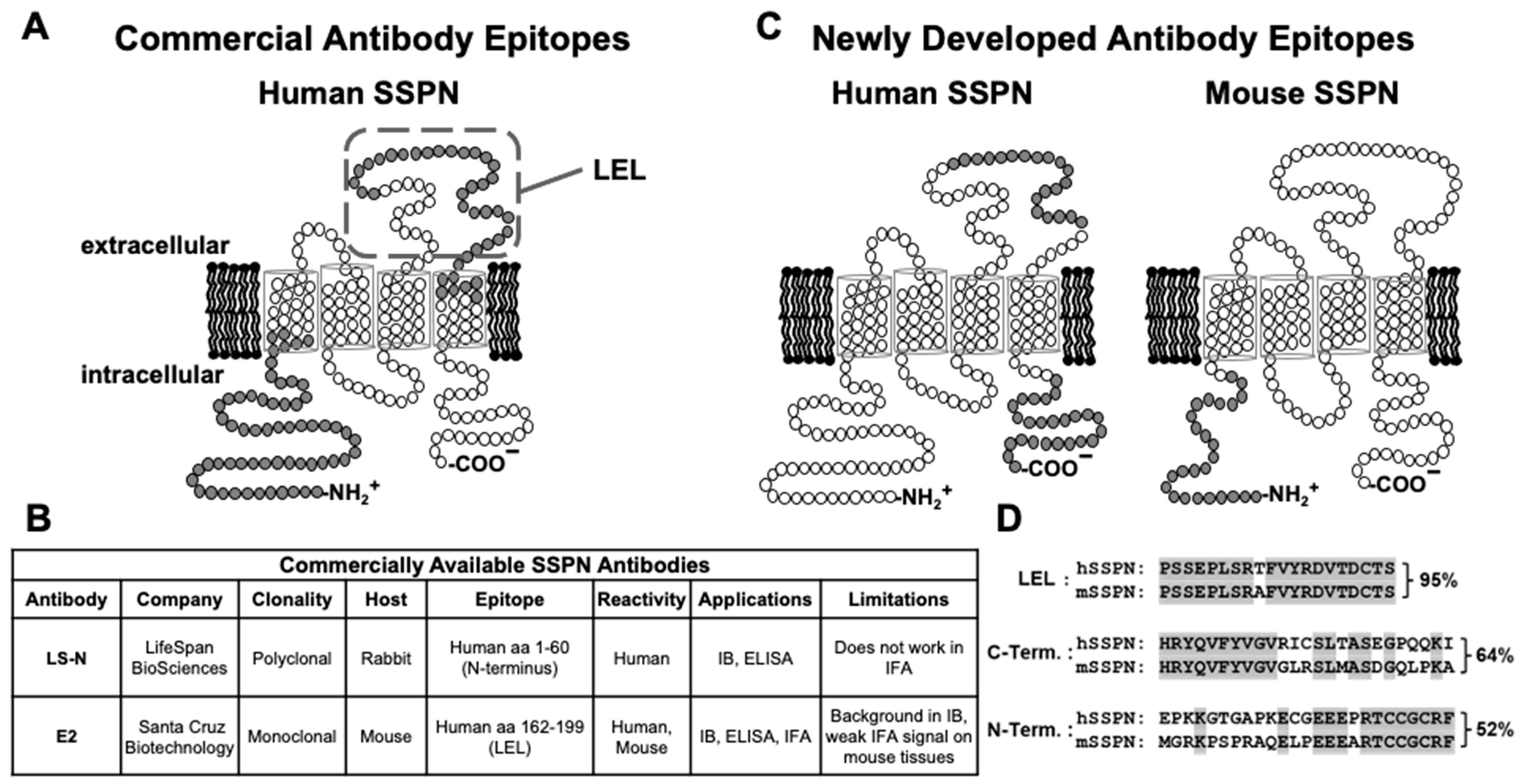

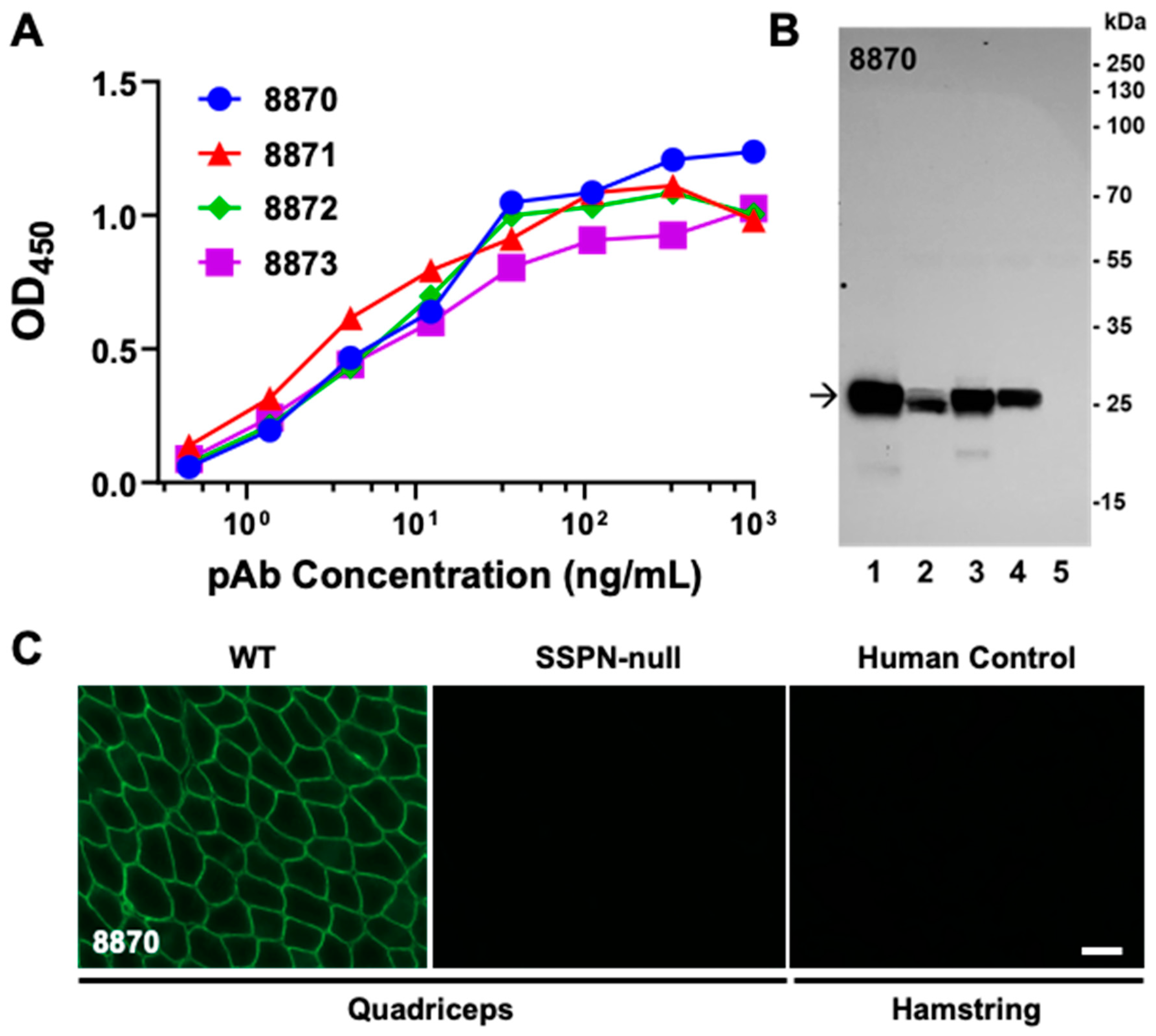


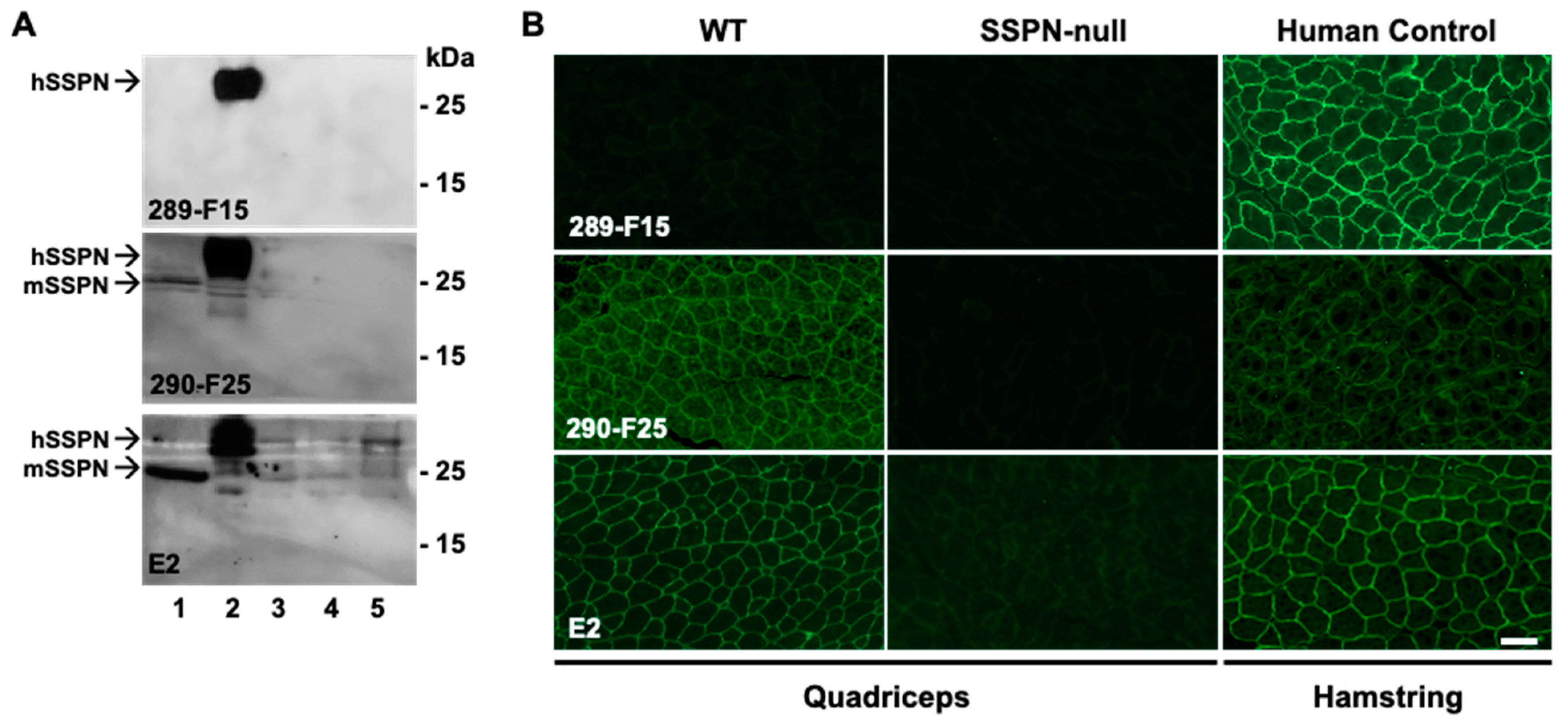
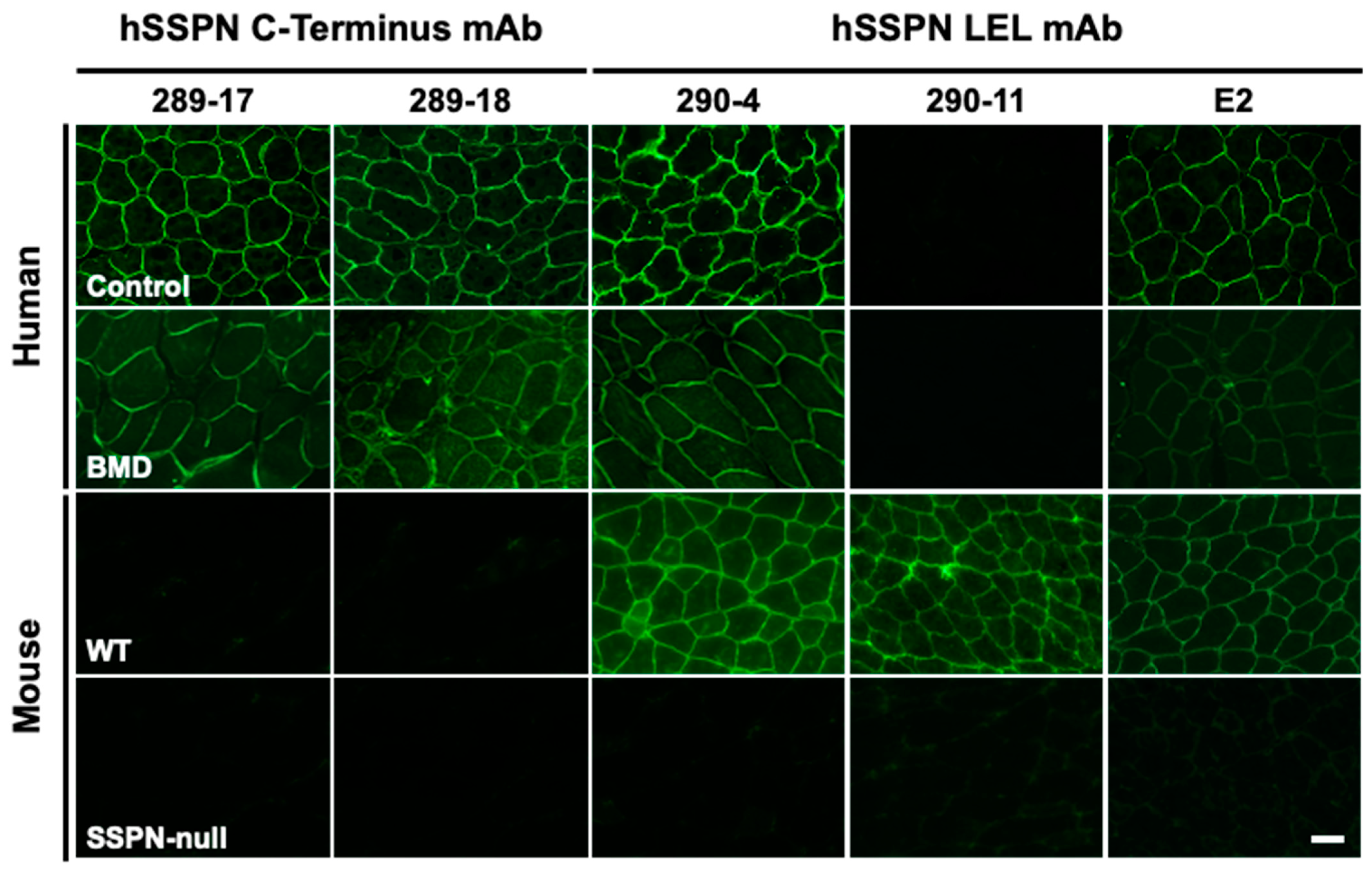

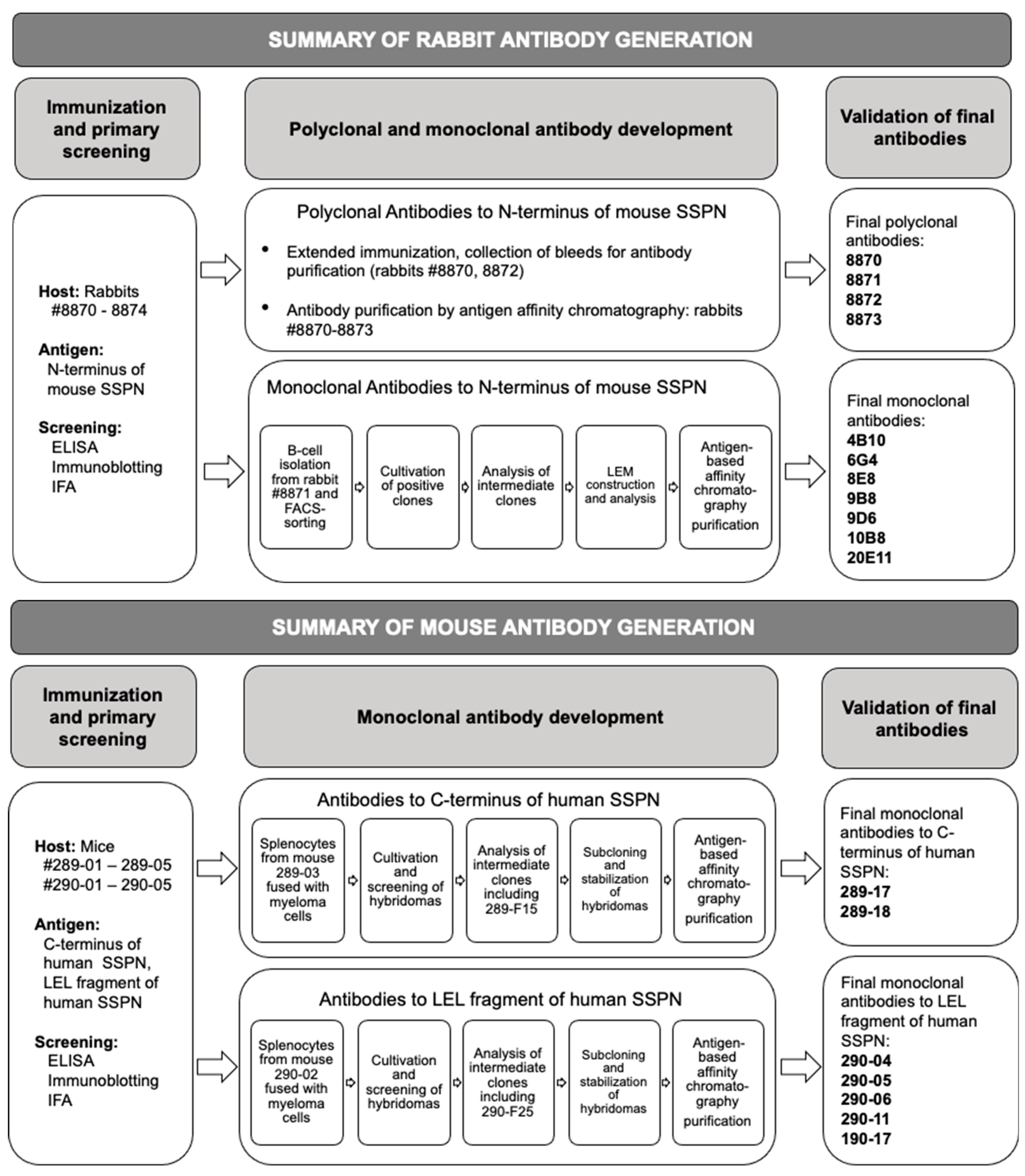
| Mouse Strain | Description | SSPN Protein Expression |
|---|---|---|
| Wild type | C57BL/6 murine strain | Normal baseline level of mSSPN |
| mdx | Dystrophin-deficient murine model of DMD | Low expression of mSSPN (5–10% of wild-type levels) [10] |
| mSSPN-TG | C57BL/6 mice with transgenic overexpression of murine SSPN in skeletal muscle | Very high level of mSSPN (~30× wild-type levels) [15] |
| hSSPN-TG | C57BL/6 mice with transgenic overexpression of human SSPN in skeletal muscle | Increased level of hSSPN (~3× wild-type levels) [10] |
| SSPN-null | C57BL/6 mice homozygous for a SSPN-null mutation from C57BL/6 background (negative control) | None [23] |
| Antibody | Clonality | Epitope | Applications and Specificity | |||
|---|---|---|---|---|---|---|
| IFA | IB | ELISA | IP | |||
| 8870 | Polyclonal | Mouse SSPN aa 1-25 (N-terminus) | Mouse SSPN | Mouse SSPN | Mouse SSPN | Mouse SSPN |
| 8871, 8872, 8873 | NT * | |||||
| 10B8 | Monoclonal | Mouse SSPN Human SSPN | ||||
| 20E11 | Mouse SSPN | |||||
| 4B10, 6G4, 8E8, 9B8, 9D6 | NT * | |||||
| Antibody | Subclass of Monoclonal Antibody | Epitope | Applications and Specificity | |||
|---|---|---|---|---|---|---|
| IFA | IB | ELISA | IP | |||
| 290-04, 290-05 | IgG2A | Human SSPN aa 167-186 (LEL) | Human SSPN Mouse SSPN | ND ** | Human SSPN Mouse SSPN | Human SSPN Mouse SSPN |
| 290-17 | IgG1 | |||||
| 290-06, 290-11 | IgG2A | Mouse SSPN | ND ** | Human SSPN | ||
| 289-17, 289-18 | IgG1 | Human SSPN aa 219–243 (C-terminus) | Human SSPN | ND ** | Human SSPN | Human SSPN |
Disclaimer/Publisher’s Note: The statements, opinions and data contained in all publications are solely those of the individual author(s) and contributor(s) and not of MDPI and/or the editor(s). MDPI and/or the editor(s) disclaim responsibility for any injury to people or property resulting from any ideas, methods, instructions or products referred to in the content. |
© 2024 by the authors. Licensee MDPI, Basel, Switzerland. This article is an open access article distributed under the terms and conditions of the Creative Commons Attribution (CC BY) license (https://creativecommons.org/licenses/by/4.0/).
Share and Cite
Mokhonova, E.I.; Malik, R.; Mamsa, H.; Walker, J.; Gibbs, E.M.; Crosbie, R.H. The Development of Robust Antibodies to Sarcospan, a Dystrophin- and Integrin-Associated Protein, for Basic and Translational Research. Int. J. Mol. Sci. 2024, 25, 6121. https://doi.org/10.3390/ijms25116121
Mokhonova EI, Malik R, Mamsa H, Walker J, Gibbs EM, Crosbie RH. The Development of Robust Antibodies to Sarcospan, a Dystrophin- and Integrin-Associated Protein, for Basic and Translational Research. International Journal of Molecular Sciences. 2024; 25(11):6121. https://doi.org/10.3390/ijms25116121
Chicago/Turabian StyleMokhonova, Ekaterina I., Ravinder Malik, Hafsa Mamsa, Jackson Walker, Elizabeth M. Gibbs, and Rachelle H. Crosbie. 2024. "The Development of Robust Antibodies to Sarcospan, a Dystrophin- and Integrin-Associated Protein, for Basic and Translational Research" International Journal of Molecular Sciences 25, no. 11: 6121. https://doi.org/10.3390/ijms25116121
APA StyleMokhonova, E. I., Malik, R., Mamsa, H., Walker, J., Gibbs, E. M., & Crosbie, R. H. (2024). The Development of Robust Antibodies to Sarcospan, a Dystrophin- and Integrin-Associated Protein, for Basic and Translational Research. International Journal of Molecular Sciences, 25(11), 6121. https://doi.org/10.3390/ijms25116121




